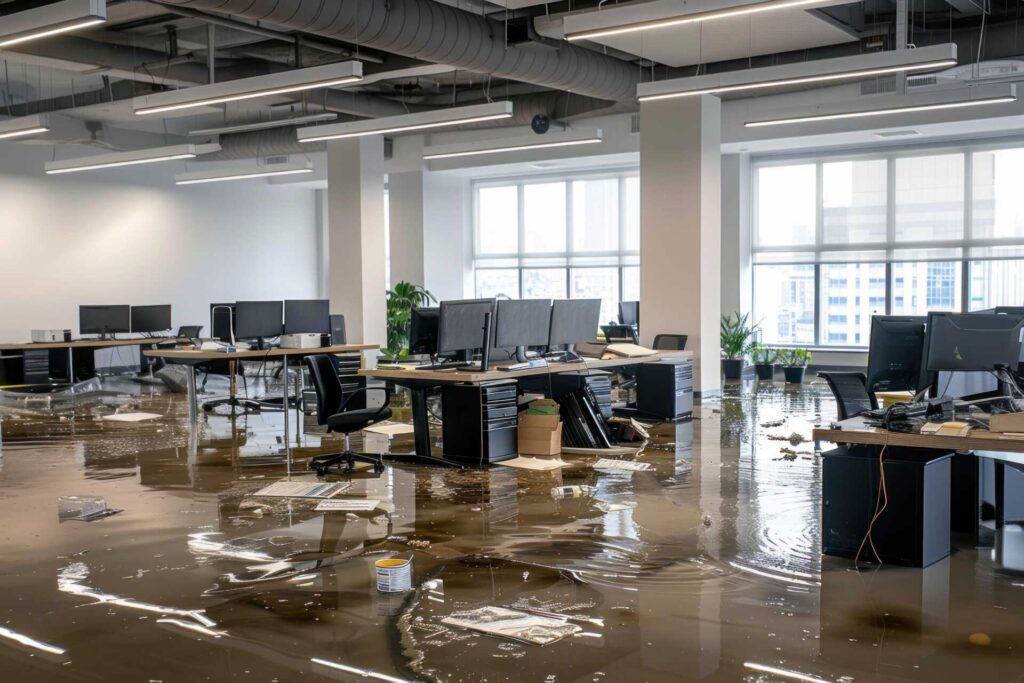
Contents
While your office was once a place of order and productivity, unexpected water damage can quickly turn it into a scene of chaos and disruption. You’ll need to act swiftly to minimize the impact: start by identifying and stopping the source of water, as this will greatly influence your restoration strategy. It’s crucial to document everything thoroughly for your insurance claim, but the real challenge lies in choosing the right restoration service. With several options available, how do you ensure you’re making the best choice for your situation? Let’s explore what you need to consider.
Key Takeaways
- Identify the source and category of water to guide the restoration process effectively.
- Document all damage meticulously for insurance claims and restoration planning.
- Consult with professional restoration services to ensure proper damage mitigation.
- Use advanced drying tools like dehumidifiers and air movers to eliminate moisture.
- Implement preventive measures such as waterproofing and regular maintenance to avoid future incidents.
Assessing the Damage Quickly
When you discover water damage in your office, it’s crucial to assess the extent swiftly to mitigate further damage and begin restoration. The first step in effective damage assessment is identifying the source of the water, as this informs the category of water damage—clean, gray, or black water—which impacts the safety measures you’ll need to implement.
Next, you’ll want to document the damage thoroughly. Take photos and make notes of all affected areas, which will be invaluable for insurance claims and future reference. This step also helps you communicate the extent of the damage to colleagues and restoration professionals, fostering a sense of shared understanding and urgency.
Moisture detection is another critical aspect. Don’t just rely on visible signs; use moisture meters to identify hidden pockets of moisture in walls, floors, and ceilings. These tools are vital for a thorough assessment, ensuring no damp areas are overlooked, which could lead to mold growth or structural issues.
It’s also essential to evaluate the impact on office equipment and furniture. Determine what can be salvaged and what must be replaced, keeping in mind that quick decisions can prevent further losses.
Professional Restoration Options
After assessing the extent of water damage in your office, it’s crucial to consult professional restoration services to manage the repairs effectively. Remember, you’re not alone in this—many have faced similar challenges, and there’s a community of experts ready to help you navigate through the restoration process.
Professional restoration companies offer a range of services designed to address water damage swiftly and efficiently. These experts are equipped with the tools and knowledge to mitigate further damage, ensuring your office is restored to its pre-damage condition as quickly as possible. Engaging these professionals speeds up the recovery process and significantly reduces your stress during such a disruptive time.
One of the first things a reputable restoration service will do is evaluate the damage thoroughly and create a detailed plan of action. This plan includes immediate steps to prevent additional water ingress and strategies to dry out affected areas.
Advanced equipment such as dehumidifiers, air movers, and moisture detectors are typically used to ensure all moisture is eradicated from the building structure and furnishings.
Moreover, these professionals can assist you with navigating insurance claims. They often have experience in documenting damages and can provide the necessary proof of loss required by your insurance provider. This can be invaluable in ensuring that your claim is processed smoothly and without unnecessary delays.
Don’t hesitate to use emergency services if the situation calls for it. Immediate action can prevent further damage and help maintain the integrity of your office structure.
Preventing Future Water Damage
To effectively prevent future water damage in your office, it’s essential to implement proactive measures and maintain vigilance. One of the most effective strategies is to invest in robust waterproofing solutions. Ensuring that your building’s foundation, walls, and other critical areas are properly waterproofed can significantly mitigate the risk of water intrusion caused by weather conditions or internal leaks.
You’ll also want to set up a regular maintenance schedule for your plumbing and roofing systems. Regular inspections can catch issues such as cracked pipes or worn-out roof shingles before they lead to major water damage. It’s crucial to address these vulnerabilities promptly; delaying repairs can lead to increased damage and affect your workplace’s overall safety and productivity.
Another key aspect of preventing water damage is moisture monitoring. Installing moisture sensors throughout your office can provide an early warning system against potential water intrusion. These sensors can alert you to elevated moisture levels, allowing you to address the issue before it escalates into significant damage.
Additionally, educate your staff about the importance of maintaining a dry and safe work environment. Encourage them to report any signs of leaks or water damage immediately. This collective vigilance can make a substantial difference in managing risks effectively.
Review
You’ve seen the havoc water damage can wreak on an office, much like a storm disrupting a calm sea. Quick assessment, tapping into professional expertise, and implementing preventive measures are your lifelines. Remember, most commercial properties will encounter some water damage during their lifespan. Staying ahead with proactive steps isn’t just wise; it’s essential. Sail smoothly by keeping your office well-maintained and ready to weather any storm.
Recent Posts
What Are Emergency Water Removal Services?
Imagine water pooling in your living room, threatening to damage your cherished belongings and compromise
How to Remove Water From Flooded Basements
Flooded basements affect nearly 14 million homes in the U.S. each year, making effective water
Your Guide to 24/7 Emergency Water Damage Repair
Did you know that the initial 48 hours after water damage are critical in preventing
